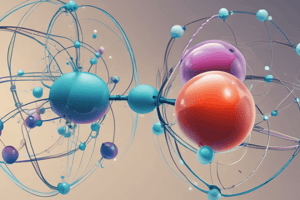Podcast
Questions and Answers
What is the primary characteristic of covalent bonding?
What is the primary characteristic of covalent bonding?
- Electrons are transferred between atoms.
- Electrons are shared between atoms. (correct)
- Only one atom contributes electrons.
- Atoms form ionic bonds.
Which type of orbitals overlap to form a sigma bond in a hydrogen molecule?
Which type of orbitals overlap to form a sigma bond in a hydrogen molecule?
- One 1s and one 2p orbital
- Two 2s orbitals
- Two 1s orbitals (correct)
- One 3p and one 3d orbital
In which molecular example does p-p overlap form a sigma bond?
In which molecular example does p-p overlap form a sigma bond?
- Hydrogen chloride (HCl)
- Chlorine molecule (Cl₂) (correct)
- Water (H₂O)
- Ammonia (NH₃)
What describes the primary characteristic of atomic orbitals?
What describes the primary characteristic of atomic orbitals?
Which statement correctly describes the strength of sigma bonds formed from different types of orbital overlaps?
Which statement correctly describes the strength of sigma bonds formed from different types of orbital overlaps?
Which of the following orbital types can be found in the energy level n = 4?
Which of the following orbital types can be found in the energy level n = 4?
What type of overlap occurs when atomic orbitals are aligned on the same axis?
What type of overlap occurs when atomic orbitals are aligned on the same axis?
In which state of carbon are two electrons in the 2s orbital and four electrons in the 2p orbitals paired differently?
In which state of carbon are two electrons in the 2s orbital and four electrons in the 2p orbitals paired differently?
Which of the following statements about s-orbitals is true?
Which of the following statements about s-orbitals is true?
How many total orbitals are present in the energy level n = 3?
How many total orbitals are present in the energy level n = 3?
What describes the geometry of sp³ hybridized orbitals?
What describes the geometry of sp³ hybridized orbitals?
Which of the following statements about sigma bonds is true?
Which of the following statements about sigma bonds is true?
Which type of bond formation involves the sideways overlap of p orbitals?
Which type of bond formation involves the sideways overlap of p orbitals?
What is a characteristic feature of pi bonds compared to sigma bonds?
What is a characteristic feature of pi bonds compared to sigma bonds?
In the context of molecular orbitals, where is the p-bonding molecular orbital located?
In the context of molecular orbitals, where is the p-bonding molecular orbital located?
What is the primary reason sigma bonds are considered stronger than pi bonds?
What is the primary reason sigma bonds are considered stronger than pi bonds?
Which of the following statements about pi bonds is incorrect?
Which of the following statements about pi bonds is incorrect?
In the context of hybridization, which characteristic applies to sp³ hybrid orbitals?
In the context of hybridization, which characteristic applies to sp³ hybrid orbitals?
Which of the following is a feature of sigma bonds?
Which of the following is a feature of sigma bonds?
Which of the following orbital configurations correctly describes the formation of pi bonds?
Which of the following orbital configurations correctly describes the formation of pi bonds?
Which statement accurately describes a characteristic of a sigma (σ) bond?
Which statement accurately describes a characteristic of a sigma (σ) bond?
Which description is correct regarding pi (π) bonds?
Which description is correct regarding pi (π) bonds?
What is the geometry of the sp³ hybridized orbitals in methane (CH₄)?
What is the geometry of the sp³ hybridized orbitals in methane (CH₄)?
How does the strength of a sigma (σ) bond compare to that of a pi (π) bond?
How does the strength of a sigma (σ) bond compare to that of a pi (π) bond?
What is a key characteristic of the electron cloud in a pi (π) bond?
What is a key characteristic of the electron cloud in a pi (π) bond?
What distinguishes a pi bond from a sigma bond in terms of orbital overlap?
What distinguishes a pi bond from a sigma bond in terms of orbital overlap?
In what way does the arrangement of electron clouds differ between sigma and pi bonds?
In what way does the arrangement of electron clouds differ between sigma and pi bonds?
What is the characteristic of hybridized orbitals in relation to pi bonds?
What is the characteristic of hybridized orbitals in relation to pi bonds?
Which statement about the strength of sigma and pi bonds is true?
Which statement about the strength of sigma and pi bonds is true?
Which describes the geometric arrangement of sp³ hybrid orbitals in methane (CH₄)?
Which describes the geometric arrangement of sp³ hybrid orbitals in methane (CH₄)?
Study Notes
Atomic Orbitals
- Atomic orbitals are the regions of space where electrons are most likely found.
- The shape and size of these orbitals depend on their energy levels.
- Each energy level (n) corresponds to a set of orbitals:
- n=1: 1s
- n=2: 2s, 2p
- n=3: 3s, 3p, 3d
- n=4: 4s, 4p, 4d, 4f
- n=5: 5s, 5p, 5d, 5f
- n=6: 6s, 6p, 6d
- n=7: 7s, 7p
- Carbon has 6 electrons.
- 2 in the 2s orbital
- 4 in the 2p orbitals
- The ground state of a carbon atom has two electrons in the 2s orbital and one electron each in the three 2p orbitals.
- The excited state of a carbon atom has one electron in the 2s orbital and one electron in each of the four 2p orbitals.
s-Orbitals:
- All s orbitals are spherical.
Covalent Bonding and Orbital Overlap
- Covalent bonds are formed when atomic orbitals overlap.
- This overlap concentrates electron density between the nuclei, creating a bond.
Types of Overlap
- Collinear Overlap: Atomic orbitals are aligned on the same axis, forming sigma (σ) bonds:
- s-s overlap
- s-p overlap
- p-p overlap
Example: Hydrogen Molecules (H₂)
- Two 1s orbitals overlap, increasing electron density between the hydrogen nuclei and forming an s-s sigma bond.
Example: Chlorine Molecule (Cl₂)
- Two 3p orbitals overlap to form a p-p sigma bond.
Example: Hydrogen Chloride (HCl)
- A 1s orbital of hydrogen overlaps with a 3p orbital of chlorine to form HCl.
p-p Overlap Strength
- Sigma (σ) bonds formed by overlapping p-orbitals are stronger than those formed by s-orbitals.
Organic Chemistry: Hybrid Atomic Orbitals (HAOs)
- Hybridization occurs when different atomic orbitals combine to form hybrid atomic orbitals (HAOs).
- Three main types:
- sp³ Hybridization: Involves one s and three p orbitals, producing four sp³ hybrid orbitals arranged tetrahedrally.
- sp² and sp Hybridization: Not described in detail in the text.
Sigma (σ) Bond
- Formed by axial overlapping of atomic orbitals.
- Involves s-s, s-p, and p-p orbital overlap.
- Stronger due to the larger extent of overlapping.
- Symmetrical about the internuclear axis.
- Free rotation exists around the bond.
- Can exist alone or with pi bonds.
- May involve hybridized or unhybridized orbitals.
Pi (π) Bonds
- Formed by sideways overlapping of p atomic orbitals.
- Involves p-p orbital overlap only.
- Weaker due to smaller overlapping extent.
- Molecular orbital is discontinuous with two electron clouds above and below the internuclear axis.
- No free rotation exists around the bond.
- Always present along with a sigma bond.
- Never involves hybridized orbitals.
Difference Between Sigma and Pi Bonds
| Feature | Sigma Bond (σ) | Pi Bond (π) |
|---|---|---|
| Formation | Axial overlapping of orbitals | Sideways overlapping of orbitals |
| Orbitals Involved | s-s, s-p, p-p | p-p |
| Strength | Stronger | Weaker |
| Symmetry | Symmetrical about internuclear axis | Discontinuous with electron clouds above and below the axis |
| Rotation | Free rotation | No free rotation |
| Presence | Can be alone or with π | Always with σ |
Formation of sp³ Hybrid Orbitals: Methane (CH₄)
- Four sp³ hybrid orbitals are formed, oriented at 109.5° to create a tetrahedral shape.
Geometry of Hybridized Orbitals
- Hybridized orbitals have a tetrahedral geometry.
sp³ Hybridization
- sp³ hybridized orbitals can be represented in ground and excited states.
Electronic Cloud
- Sigma Bond: The electron cloud is symmetrical about the internuclear axis.
- Pi Bond: The electron cloud is discontinuous with electron clouds above and below the internuclear axis.
Studying That Suits You
Use AI to generate personalized quizzes and flashcards to suit your learning preferences.
Description
This quiz covers the concept of atomic orbitals, their shapes, and energy levels, along with covalent bonding and orbital overlap. Learn about how electrons are distributed in orbitals and the types of overlaps that form covalent bonds. Test your understanding of these foundational topics in chemistry.




